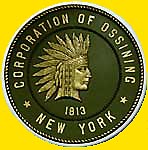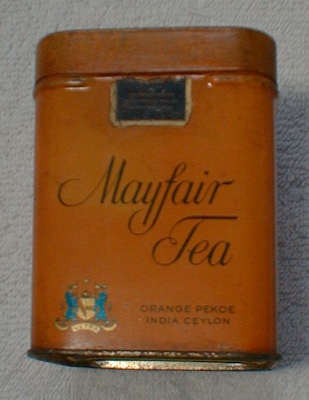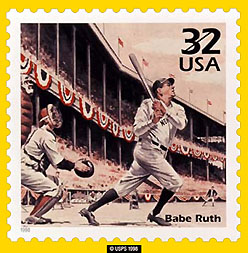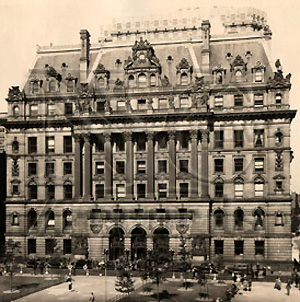When my father entered Sing Sing, it was a century-old prison, opened initially in 1825. It was named after the nearby village of Sing Sing and the Sint-Sinck Indians, who had lived along the Hudson River.
Sing Sing =
'Stone Upon Stone'

A brief history of Ossining by Village Historian William Joseph Reynolds can be accessed on the village's official web site by clicking the above image of the village seal.
|
|
The name is derived from earlier words, which mean “stone upon stone.” In 1901, the local village, in an effort to disassociate itself from the prison, changed its name to Ossining.
Sing Sing was constructed to replace Newgate Prison in New York City, a twenty-seven year old structure, opening a year after George Washington left the presidency. A state commission chose a site that included a stone quarry, which provided ready materials for the building of Sing Sing and later prison labor.
While it was my brother’s memory that made me aware of Dad’s time in prison, it was my own memory that made me begin a search to discover something about his life in Sing Sing.
It came to me one early morning – I recall the time and date exactly - at 6:33, on July 28, 2000. Awake and lying still in bed for a few moments, before the dogs heard my change of breathing and began nudging me to take them out, the memory suddenly appeared in my mind for no apparent reason. Nothing related to Dad had been in my thoughts or dreams the previous night.
I remembered two autographed baseballs in the top drawer of a dresser in my parents’ bedroom in Perth Amboy, New Jersey. I saw them in the mid-forties, before the war was over. I must have been twelve or thirteen at the time and found the balls snooping among my father's things in his underwear drawer.
Example of Mayfair Orange Pekoe tea tin.

Ten tins have become collector items. This Mayfair tea tin example can be found on the site of J. Patrick Mahoney that clicking the above image.
|
|
The baseballs lay in the back on a stack of ironed handkerchiefs. In that same
drawer, there was also an orange Mayfair Tea can containing a few old and, I suppose, rare coins. I still have the tea can.
An old shellacked and yellowed baseball remains foremost in my memory. An avid baseball fan as a boy, I recall my astonishment seeing that the ball was autographed by Babe Ruth and the New York Yankees.
The baseball was dated either 1927 or 1929, neither my brother nor I recall which year it was. That unforgettable Yankee team of the twenties, with Babe Ruth hitting sixty homeruns (1927) is still considered by many baseball experts to be the best team ever to have played the game.
In the dresser drawer, there was also a baseball autographed by the New York Giants, but again neither of us remembers the date written on it. My brother thinks a third autographed ball was in the drawer, but to my dismay, does not recall the year, what team or whose names were on it.
All three baseballs were inscribed, “To Mert,” my brother’s first name, which he changed to Michael much later in life. The inscriptions were written in black ink across the baseballs in a large half-inch calligraphy. Since the inscriptions did not cover any of the many signatures on each baseball, it seems likely they were written on the balls before the players signed them.
The autographed baseballs, now undoubtedly worth thousands of dollars, are lost. The balls disappeared sometime during the early forties and I do not know what happened to them. My suspicion is that they probably were stolen by one of the boys who coveted them when I showed them off. My brother thinks the baseballs were used and scuffed-up rather than preserved for the future, but that may well be wishful thinking, knowing how much they are worth today.
Babe Ruth postage stamp.

The "Sultan of Swat," flappers, jazz, and vintage cars were among "Roaring 20s" icons highlighted by the U.S. Postal Service May 28, 1998 when it unveiled 15 postage stamps saluting the decade as part of its Celebrate the Century stamp and education program. Click the image to access a larger stamp image and link to the stamp series on the USPS web site.
|
|
What struck me the morning when I awoke thinking about the baseballs was not their monetary value, but rather their meaning in my father’s life story. The date on the Yankees ball coincided with his term in Sing Sing, which never had occurred to me before.
As I thought about that coincidence, it also occurred to me that my father, twenty-seven when he entered prison, was a fine athlete (unlike his sons) who played baseball all his youth. The obvious question then came to mind. Could it be that Dad was on the prison team that played the New York Giants and Yankees in Sing Sing?
I started the search for my dad’s life in Sing Sing the same day the memory appeared to me. To my astonishment, it soon became apparent that no one in my father’s family, including my brother, knew the precise years he had been in prison. And. not surprisingly, given the sensitive nature of such a thing, no written record of his prison sentence existed anywhere among our family papers.
Since I was born in September, 1932, presumably nine months after his parole from prison, I had assumed my dad’s incarceration lasted from 1926 to late 1931. My brother Mike was a “honeymoon child” born nine months after my parents’ marriage in June, 1920 and, since he remembered visiting Dad in prison when he was five years old, I believed I too was a child conceived on a honeymoon – a second and post-prison honeymoon!
Knowing my father received a five-year sentence in Sing Sing and assuming he was paroled in late 1931, I immediately contacted the New York City Municipal Archives to discover the dates of his arrest and conviction. I expected the information would be easily found, but, surprisingly, there was no record of a robbery arrest, trial or conviction for Harry N. Gold in the twenties.
Surrogate's Court/Hall of Records
31 Chambers St. - Home of Municipal Archives

With records back to the 17th century, the Municipal Archives houses 150,000 cubic feet of historical government records related to, among other things, the Almshouse, City Cemetery, Coroner and Office of Chief Medical Examiner, the Courts and District Attorney Offices. For more on the archival collections and services, visit the NYC Dept. of Record & Information Services home page. Click the above circa 1930s image of its building from the DORIS site to access its home page.
|
|
E-mail, postal correspondence and phone calls to the New York State Archives in Albany and Sing Sing Correctional Facility were no more informative. Sing Sing’s inmate files for those years, I learned, had been sent to the State Archives.
Archivist Jim Folts in Albany sent me a long list of the state’s Correctional Facility holdings, but Sing Sing’s oldest inmate files were not among them. The prison’s admission registers were still available, but could only be accessed by date of conviction, which I did not know.
I next examined the New York Times Index for the years, 1922 to 1930, to see if a robbery arrest of my father was mentioned. I
was surprised to find a number of arrests for several Harry Golds but they were for burglary, confidence crimes, embezzlement, pick pocketing and fur robbery. There was no mention of a Harry N. Gold arrested for armed robbery. I read all the related Times articles on microfilm, but found none of the arrested men fit Dad’s age or description. And none of them had an Ossining home address.

